Top News

January 29, 2019 Ryukyu Shimpo
Okinawa University and some 250 law students welcomed Gov. Denny Tamaki as a guest lecturer on Jan. 28. Gov. Tamaki shared his upbringing and how he entered the world of politics.
Tamaki told the students that “the accumulation of small experiences become the foundation to how you decide what changes are needed in the future,” and encouraged them to “cherish the experiences only available to you today.”
The governor’s guiding principles are independence, coexistence and diversity.
To this day, he remembers being bullied as a child due to his biracial ethnicity, and his mother offering him the Okinawan saying, “All ten fingers are different.”
Tamaki was elected to the Lower House of the Diet as a member of the then Democratic Party of Japan for the first time in 2009.
He spoke on the majority take-over from the Liberal Democratic Party: “The people sought change, and shifted the political landscape.” He stressed that “You can change politics.”
When asked by a student whether the results of the prefectural referendum will be given weight, the governor answered that “while the referendum is not legally binding, it clearly asserts Okinawa’s position. It’s a way to provide the central government with a basis for decision making.” An economic law student, Ryusei Kitayama, 19, said, “the lecture sparked my interest in elections. I wanted to hear more from the governor.”
(English translation by T&CT and Monica Shingaki)
Go to Japanese
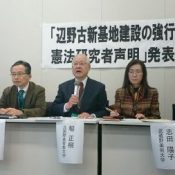
January 24, 2019 Ryukyu Shimpo
On January 24 a group of constitutional scholars including former professor Masaki Ina of the International Christian University gathered at the House of Representatives in Tokyo and presented a researchers’ statement opposing the forced construction of the Henoko base. As of January 24, 131 constitutional scholars have endorsed the statement.
The scholars who attended the press conference appealed that, “This is a matter of the Okinawan people’s fundamental human rights, and at the same time it is a matter of democracy in Japan.
” They also demanded that construction be halted until the results of a prefectural referendum, which will ask citizens if they support or oppose the Henoko land reclamation, are announced.
According to Ina, this is the first time that volunteer constitutional scholars have issued a statement in regard to the Henoko base construction issue.
There are 500 to 600 constitutional scholars in Japan. Those endorsing the statement continue to recruit advocates.
The statement points out the problem that, “Construction of the new base in Henoko by the Abe administration is a violation of democracy and local autonomy.
” In addition it states, “We must say that the claim ‘Henoko is the only option’ by Abe’s administration is a deception.” Furthermore it details that, “All concerned volunteer constitutional scholars strongly oppose the construction of the new Henoko base in order to leave a peaceful and safe Japan, a Japan with rich nature, to future generations.”
Ina said, “Construction of the Henoko base is a problem for Japanese citizens.
Base construction that overlooks residents’ wishes is contrary to the principle of local autonomy in the Constitution.
” Regarding the prefectural referendum, he said, “It is an important occasion to clarify how people in Okinawa truly feel.”
Hiroshi Sasanuma, a professor at Shizuoka University, emphasized, “It’s an issue that shakes the foundation of democracy. We are wounding and trampling the human rights of Okinawan people by neglecting the Henoko issue and not discussing it as a matter of the entire nation of Japan.”
Professor Yoko Shida of Musashino Art University said, “The opposition of the prefectural people is one way for them to express their will, as guaranteed by the Constitution.
It should never be neglected or ignored.
Forced sediment deposits overstep the limits permitted by the Constitution.” In regard to the results of the prefectural referendum, she said, “The person in charge of political affairs needs to, at minimum, faithfully heed the resulting public sentiment.”
Yuichiro Ishikawa, a professor at Sei Gakuin University, said, “Aside from the rationality of base construction, there are obvious elements of harassment toward Okinawa, alike to sexual violence. The method of forcing the weak with overwhelming power reminds me of various aspects of the current administration, and Henoko appears to be symbolic of that.”
Professor Shigeaki Iijima of Nagoya Gakuin University said, “What the Abe administration is doing in Okinawa is exactly trampling the ‘rule of law.’ They are not qualified to claim to comply with the rule of law against China and others.”
In addition to the Cabinet, the Ministry of Defense, the Ministry of Foreign Affairs, the Self Defense Force, the Okinawa Prefectural Government, and other official agencies, the statement will be sent to all political parties. In the future, the constitutional scholars are considering some sort of appeal activism with proponents of the statement.
(English translation by T&CT and Megumi Chibana)
Go to Japanese
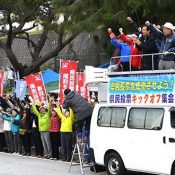
January 27, 2019 Ryukyu Shimpo
On January 26, a group opposing construction of the Henoko base held a kickoff rally in front of a gate to Camp Schwab.
This rally was held to address the prefectural referendum that will ask citizens for a “yes” or “no” answer to land reclamation as part of Henoko base construction. According to the organizer, the Prefectural Referendum Council Against the New Base, 3,000 people attended. The rally called for citizens across Okinawa to cast a “no” vote to land reclamation at the referendum on February 24.
Those gathered at the rally burned hot with fervor, repelling the cold. Aside from the placards against new base construction, there were also horizontal banners and other signs encouraging citizens to participate in the prefectural referendum.
Representative of the Council Against the New Base and former mayor of Nago City Susumu Inamine said, “Even if the vote mainly demonstrates ‘no’ Henoko base, the Japanese government will ignore it, and there are only the options of ‘yes’ or ‘no’ to demonstrate public opinion. Let’s again demonstrate our popular will opposing Henoko [construction] through the prefectural referendum on February 24.”
People across generations attended the rally, including youths who developed a signature collecting campaign, as well as parents and children.
Azusa Kayoda, 40, of Chatan Town and her daughter Haruka, 8, visited Henoko for the first time, together. Kayoda said, “Public opinion is rising, I hope it ends up stopping land reclamation.”
(English translation by T&CT and Erin Jones)
Go to Japanese
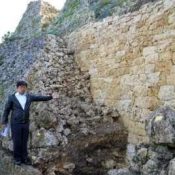
January 24, 2018 Ryukyu Shimpo
Nakagusuku – A castle wall that appears to have been constructed in the early 14th century was discovered at the Nakagusuku Castle Ruins.
The wall was found on the inside of a more recent castle wall constructed at the end of the 19th century.
The Nakagusuku Board of Education (BoE) made the discovery while removing stones as part of ongoing castle repairs.
It appears to have been constructed during the time of a Nakagusuku chieftain prior to the more well-known folklore of when Gosamaru inhabited the castle.
Previously, it was believed that Nakagusuku castle was constructed in the latter half of the 14th century, however as time moved on, the history of the castle could have been re-written.
A specialist explained, “It could be said that it was a show of strength on the part of the chieftain who constructed it. It is rare for the time period of the masonry to be identified. This is quite the rare discovery.”
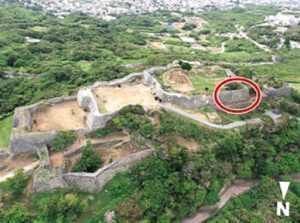
The location of the newly discovered wall from the early 14th century (circled and red; image provided by the Nakagusuku Board of Education)
A piece of Chinese pottery that indicated the earth serving as the foundation for the wall dated from the end of the 13th century to the start of the 14th century was discovered, and this led to the determination of the approximate date of when the wall was constructed.
There were other unique characteristics such as shaved off corners, delicately manufactured quarried stone, and neat stacking that indicated it was constructed after Ichi no Kaku.
In the first half of the 15th century, either the chieftain at the time of Gosamaru constructed a new wall on top of the one just discovered.
The wall was 13 meters in height, and is an expansion of Ichi no Kaku. It appears to have been built to fortify the defenses of the castle.
The discovered older wall was completely covered by the newer wall built over it. As the months and years passed on after its initial construction, the damage of the wall began to show, so the new wall was built over it, preserving the older wall on the inside.
Starting February 4, reconstruction of the masonry will begin. BoE cultural office head Shin Tokuchi said, “It is amazing that the wall was uncovered. I want to show this to many people.”
(English translation by T&CT and Sam Grieb)
Go to Japanese
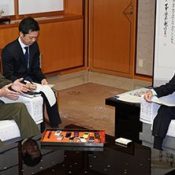
January 24, 2019 Ryukyu Shimpo
Okinawa Governor Denny Tamaki held his first meeting with the U.S. military’s top commander in Okinawa, Okinawa Area Coordinator Lieutenant General Eric Smith.
At the meeting, the governor told the OAC that regarding the over-burdening of U.S. bases on the island,
“We have already since passed our breaking point.”
Tamaki also protested about repeated incidents involving U.S. military aircraft such as the part dropped form a U.S. helicopter onto the grounds of Futenma Dai-ni Elementary school, were, “trapping many Okinawan residents in a state of fear,” and demanded that a notification system be established in the case of an incident or accident involving the U.S. military.
Lt. Gen. Smith commented, “For the sake of the alliance, we are making preparations for the security of Japan, and will continue to offer safety to its people, including Okinawans,” and added, “We want to make safety concerns of Okinawa our highest priority.”
(English translation by T&CT and Sam Grieb)
Go to Japanese
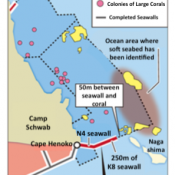
January 23, 2019 Ryukyu Shimpo
The Okinawa Defense Bureau (ODB) stated its perspective that as part of construction of the Futenma Replacement Facility in Henoko, even without transplanting coral, construction of the seawalls on the Oura Bay side of Cape Henoko will not affect the approximately 40,000 colonies of coral living in the area.
This information was reported at a meeting of the Environmental Oversight Committee (chaired by Yoshiyuki Nakamura, a graduate professor at Yokohama National University) that opened on January 22.
Construction is moving forward despite the Okinawa Prefectural Government (OPG) rejecting the application for special harvesting for transplantation of the coral.
One scholar stated, “If the seawalls are built, there will be a negative effect on coral.”
There are several small colonies of coral at the site planned for construction of the K8 seawall.
According to the results of water pollution, water current, and water temperature simulations, it is possible to construct 250 meters of the 515 meter-long seawall without affecting the coral.
That 250-meter stretch ends 50 meters short of the closest coral.
The ODB applied to the OPG for special harvesting approval relating to coral transportation on the Oura Bay side of seawall construction, but the OPG rejected the application.
It was also reported at the Environmental Oversight Committee meeting that as of December 2018 there have been no observed signs of feeding by dugong.
At most, within one month there were once 120 signs of feeding by the dugong observed over the areas of Henoko, Kayo, and Abu.
However, these signs have been decreasing since September, and there have been none observed at all in December and January.
According to Environmental Oversight Committee Chairman Nakamura, in committee discussions the members expressed their viewpoint that when considering the details of and relating to construction, “It is difficult to imagine what the effects of construction will be.”
(English translation by T&CT and Erin Jones)
Go to Japanese

January 20, 2019 Ryukyu Shimpo
The village of Yomitan has been working on digitizing copious amounts of records as part of the “Okinawan Post-War Education History and Reversion Archive Project.”
The village hosted a briefing session on Jan. 19 to report on the progress of the project.
The event was held at the Zakimi Castle Ruins & Yuntanza Museum, a UNESCO World Heritage site in Yomitan.
The digitized records are part of the 80,000 photographs, films, books and audio tapes Yomitan inherited from the Okinawa Teacher’s Union in 2013.
Takaaki Muraoka, a doctoral student of political science at Kyushu University’s Graduate School said, “These records are valuable, as many of the photos are symbolic of post-war Okinawa.”
The project is funded by a one-time donation and funds sourced by crowdfunding.
So far 16,000 negative films and 6,440 booklets have been digitized. Before Okinawa’s reversion to Japan, Chobyo Yara, a Yomitan native, served as the president of the teacher’s union.
Thus, Yomitan was chosen to inherit the archives. Some of the digitized documents are now available on the Yomitan Village website.
Digitized photographs depict scenes of the Ainu people speaking with Yara in Naha City; the 1969 Camp Schwab investigation in Henoko, Nago City; and protesters and riot police clashing after the Legislature of the Ryukyu Government passed a vote of thanks to the signing of the Okinawa Reversion Agreement in 1971.
Muraoka joined Genpei Ishikawa, a former president of the Okinawa Teacher’s Union and former secretary to Yara, and Yoshihiko Izumikawa, director of the Yomitan Village Library, at the briefing session. The three debated in a panel discussion after they each gave a brief.
Muraoka analyzed both the American records and the inherited records. “You start to see myriad things. For instance, changes in ways the U.S. expropriates land, and the U.S. manipulation of elections,” he said.
Ishikawa hopes of “building a Chobyo Yara memorial, storing the records there, and use them to foster rich minds.”
Izumikawa told the crowd, “Archives come to life when people come to see them. Everyone should make full use of it.”
About 20 people attended the briefing session. A photo exhibit of 43 photographs handpicked from the archives is on display through Feb. 3 at the Yuntanza museum.
Archive books are available for viewing at the Yomitan Village Library.
(English translation by T&CT & Monica Shingaki)
Go to Japanese
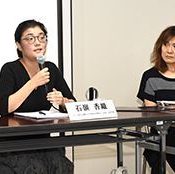
January 20, 2019 Ryukyu Shimpo
On January 19, a symposium titled “The East Asia Situation and Okinawa”, organized by the East Asia Community Institute’s Ryukyu/Okinawa Center, was held at the Ryukyu Shimpo gallery in Izumizaki, Naha. Peace Philosophy Center director Satoko Norimatsu and others discussed such topics as the relationship between Okinawa and reducing tension on the Korean Peninsula where North and South have long been at odds.
Norimatsu talked about efforts to overcome white male supremacy in Canada, where she lives, and a human rights museum there.
“Hiding the truth and denying history are the biggest obstacles to reconciliation,” said Norimatsu.
“This can be surmounted by overcoming borders and nationalism and turning our eyes to the stories of individuals.”
She discussed the Nanking massacre and the Battle of Okinawa and said, “Okinawa is in solidarity with other victim nations in terms of having been the victim of Imperial Japan. Learning about history will help lead to the construction of peace in East Asia.”
Kaori Ishimine, co-director of the “Association for Creating a Peaceful Future for the Children of Tidanufa Island,” an organization that opposes deployment of the Japan Self-Defense Forces (SDF) on Miyako Island, discussed the current SDF deployment situation. “
We need to think of the issue of SDF deployment and reinforcement as a problem for Okinawa as a whole.
Just stopping the Henoko [new base construction] won’t stop the militarization of Okinawa as a whole,” she said. She argued that the SDF’s contributions to disaster reconstruction have led to a taboo against criticism of the buildup of SDF troops and said, “We, who know the truth [of the increased militarization], must convey to others what is really happening.”
Masaki Tachikawa, a journalist who has long covered the Korean Peninsula, criticized the Abe administration, saying, “The Abe administration would not be happy about reunification of North and South Korea. Meanwhile, there has never been a [Japanese] administration that both North Korea and South Korea despised so fiercely.”
He gave an analysis of Japan’s situation, saying, “In Germany, the parliament passed a resolution to officially apologize for the actions of the Nazis. In Japan, a Diet resolution apologizing for pre-war and wartime acts of aggression would entail a repudiation of the Emperor, and so conservative forces find themselves unable to take such a step.”
(English translation by T&CT and Sandi Aritza)
Go to Japanese
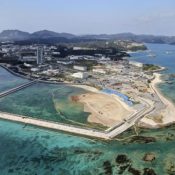
January 22, 2019 Ryukyu Shimpo
It was learned January 21 that the Japanese government is looking to being with a revised construction plan this spring, with an eye towards improving the soft foundation of the undersea area where land reclamation is taking place as part of the new base construction in Henoko, which is tied to the relocation of MCAS Futenma.
By March, the government plans to gather the results from a geological boring survey and then submit an application for a revised construction plan to Okinawa within the year.
Okinawa Prefecture had previously indicated that the soft foundation would lengthen construction time, and Okinawa Governor Denny Tamaki has already hinted that he will reject the revised construction plan application.
It appears that this will become yet another point of contention in the ongoing base issue, intensifying the years-long battle between the governments of Okinawa and Japan.
Meanwhile, the Okinawa Defense Bureau (ODB) announced on January 21 that land reclamation in “land filling zone 2,” which neighbors the current land reclamation area, is set to begin March 25.
A representative from the Japanese government clarified the revised construction plan to improve the foundation.
Previously, the Ministry of the Environment (MoE) was conducting a survey on the existence of a soft foundation, and refrained from making any statement while the survey was ongoing.
However, now with the confirmation of the soft ground, they have deemed it necessary to improve the foundation.
The area that requires a revised construction plan is the deeper undersea area on the Oura Bay side of the construction zone, where the geological boring survey conducted by the MoE discovered that there were many locations where the ground had an “N value,” which measures hardness, was zero.
The MoE explained that they will give their “over all impressions” of the solidity of the foundation based on an additional survey currently being conducted.
The MoE plans to have the results of the geological survey by year’s end. The Japanese government will create revised construction plans once for improving the foundation once they have received the results of the survey, and after making all the necessary preparations, submit the application to the Okinawan government.
The existence of a soft foundation was one of the main reasons given by the Okinawan government when they rescinded the approval for land reclamation work in August of the previous year.
Governor Tamaki has claimed that the foundation improvement work will extend the length of construction time and subsequently balloon construction costs, and that the Henoko relocation championed by the Japanese government will only further entrench the existing MCAS Futenma.
(English translation T&CT and Sam Grieb)
Go to Japanese

January 22, 2019 Ryukyu Shimpo online edition
At a cabinet meeting on January 22 the Japanese government agreed to nominate a candidate site comprised of Amami Oshima, Tokuno Island, a northern part of Okinawa Island, and Iriomote Island (hereafter referred to as the Amami-Okinawa site) for inscription on the World Natural Heritage List.
The nomination file is to be submitted to the World Heritage Center by February 1.
Following a field inspection by the IUCN (International Union for Conservation of Nature) planned for summer or autumn this year, the government is aiming for inscription in the summer of 2020.
Although the government aimed to have the Amami-Okinawa site inscripted on the World Heritage List last summer, the IUCN recommended deferral of the nomination and requested a fundamental revision of the nomination file.
The government has withdrawn the initial nomination and will renominate the site.
(English translation by T&CT and Erin Jones)
Go to Japanese
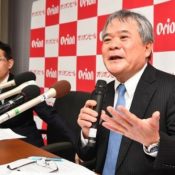
January 24, 2019 Ryukyu Shimpo
On January 23, Orion Beer announced the tender offer for Orion shares by Nomura Holdings, Inc. (HD) and U.S. investment firm The Carlyle Group, along with their approval to become a wholly owned subsidiary company.
In short, Orion intends to accept the buyout by both companies.
The price per share of the tender offer is 79,200-yen and the estimated buyout price is about 570-billion yen.
Orion hopes to strengthen their competitiveness with the help of Nomura HD and Carlyle.
Orion explained that some of the factors for accepting the buyout by Nomura HD and Carlyle are the decreasing number of beer consumers and that not all overseas ventures are profitable.
Some shareholders also voiced their desire to cash in their shares.
Orion accepted the offer made by Nomura HD and Carlyle in order to resolve issues.
Orion also hopes this will strengthen sales structure and marketing strategies, along with improving the profitability of the hotel and real estate industries.
According to Nomura HD and Carlyle, this is not an investment that focuses on the asset value of real estate and they do not plan on selling real estate.
President Yonamine who held a press conference at the headquarters in Urasoe City on January 23 said, “Even under the new organization led by Nomura and Carlyle, we will become a beer company that will be loved by people from a wide range of generations. And while maintaining the DNA as a company that took root in Okinawa, we will become a company representing Okinawa the younger generation of employees can be proud of.”
The plan is to have Nomura HD and Carlyle complete their operations in about five years, with an initial public offering (IPO) also in mind.
The tender offer of Orion shares will move forward with a management buyout (MBO) format in which a company acquires their own shares by utilizing funds from moneymen.
The tender offer period is between January 24 and March 22.
The acquisition of shares will be undertaken by Nomura Capital Partners (NCAP), a subsidiary of Nomura HD, along with a special purpose company (SPC) Carlyle invests in.
Following the acquisition of shares, the MBO format will be followed by having Orion Chairman Yoshio Kadekaru and executives invest in the SPC.
Orion will be built in as an affiliate of the SPC.
Following the completion of the buyout, there will be 10 to 11 Orion directors.
NCAP and Carlyle will each have three, Orion will have three to four, and one external director from Asahi Beer will also be welcomed.
(English translation by T&CT and Chelsea Ashimine)
Go to Japanese












 Webcam(Kokusai Street)
Webcam(Kokusai Street)


